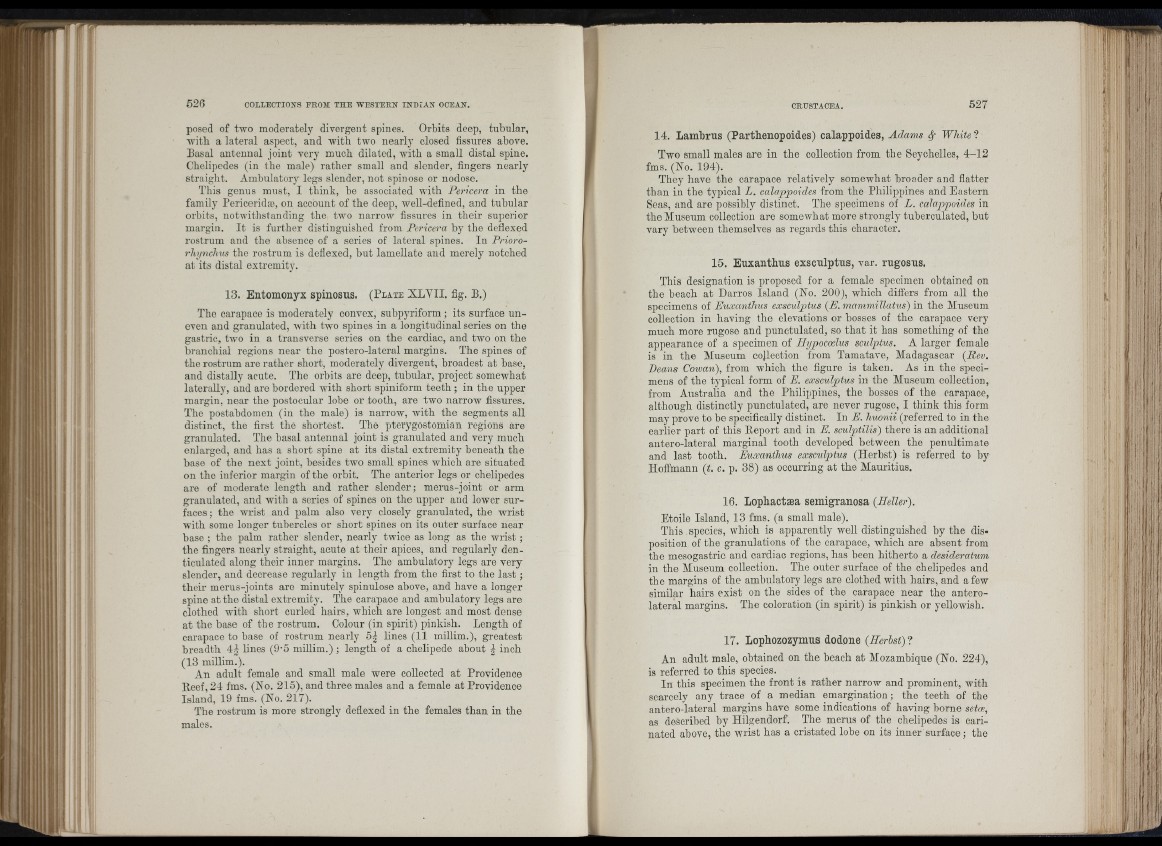
IM
h I
-i î
mi
i :||l
r .
posed of two moderately divergent spines. Orbits deep, tubular,
witb a lateral aspect, and witb two nearly closed fissures above.
Basal antennal joint very mucb dilated, witb a small distal spine.
Cbelipcdes (in Ibe male) ratber small and slender, fingers nearly
straight. Ambulatory legs slender, not spinose or nodose.
This genus must, I think, be associated with Pericera in the
family Periceridac, on account of tbe deep, well-defined, and tubular
orbits, notwithstanding tbe two narrow fissures in their superior
margin. I t is further distinguished from Pericera by tbe defiexed
rostrum and the absence of a series of lateral spines. In Prioro-
rhynclius the rostrum is defiexed, but lamellate aud merely notched
at its distal extremity.
13. Entomonyx spinosus. (P late XLYII. fig. B.)
The carapace is moderately convex, subpyriform; its surface uneven
and granulated, witb twm spines in a longitudinal series on the
gastric, two in a transverse series on the cardiac, and two on tbe
branchial regions near tbe postero-lateral margins. The spines of
tbe rostrum are ratber short, moderately divergent, broadest a t base,
and distally acute. The orbits are deep, tubular, project somewhat
laterally, and are bordered witb short spiniform teeth ; in the upper
margin, near the postocular lobe or tooth, are two narrow fissures.
Tbe postahdomen (in tbe male) is narrow, witb the segments all
distinct, the first the shortest. The pterygostomian regions are
granulated. Tbe basal antennal joint is granulated and very mucb
enlarged, and has a short spine at its distal extremity beneath the
base of the next joint, besides two small spines wbicb are situated
on tho inferior margin of tbe orbit. The anterior legs or chelipedes
are of moderate length and rather slender; merus-joint or arm
granulated, and with a series of spines on the upper and lower surfaces
; the wrist and palm also very closely granulated, tbe wrist
witb some longer tubercles or short spines on its outer surface near
base ; the palm ratber slender, nearly twice as long as the w r is t;
tbe fingers nearly straight, acute at their apices, and regularly denticulated
along tbeir inner margins. Tbe ambulatory legs are very
slender, and decrease regularly iu length from the first to the l a s t ;
tbeir merus-joints are minutely spinulose above, and have a longer
spine at the distal extremity. The carapace and ambulatory legs are
clothed with short curled hairs, which are longest and most dense
at tbe base of the rostrum. Colour (in spirit) pinkish. Length of
carapace to base of rostrum nearly 5 | lines ( I I millim.), greatest
breadth 4 | lines (9-5 millim.) ; length of a chelipede about | inch
(13 millim.).
An adult female and small male were collected at Providence
Eeef, 24 fms. (Xo. 215), and three males and a female at Providence
Island, 19 fms. (No. 217).
Tbe rostrum is more strongly defiexed in tbe females than in tbe
males.
14. Lambrus (Parthenopoides) calappoides, Adams Sf White ?
Two small males are in the collection from tbe Seychelles, 4 -12
fms. (No. 194).
They have the carapace relatively somewhat broader and flatter
than ill the typical L . ccdappoides from the Philippines and Eastern
Seas, and are possibly distinct. The specimens of L. calappoides in
tbe Aluseum collection are somewhat more strongly tuberculated, bnt
vary between themselves as regards tbis character.
15. Euxanthus exsculptus, var. rugosus.
This designation is proposed for a female specimen obtained on
the beach at Darros Island (No. 200), which difiers from all the
specimens of Euxanthus exsculptus (E. mammillatus) in the Aluseum
collection in having the elevations or bosses of the carapace very
mucb more rugose and punctulated, so th at it has something of tbe
appearance of a specimen of Hypocoelus scidptus. A larger female
is in tbe Aluseum collection from Tamatave, Aladagascar (Rev.
Deans Cotvan), from which tbe figure is taken. As in tbe specimens
of the typical form of E. exsculptus in tbe Aluseum collection,
from Australia and tbe Philippines, tbe bosses of the carapace,
although distinctly punctulated, are never rugose, I think this form
may prove to be specifically distinct. In E. huonii (referred to in the
earlier part of this Eeport and in E. sculptilis) there is an additional
antero-lateral marginal tooth developed between tbe penultimate
and last tooth. Euxanthus exscidptus (Herbst) is referred to by
Hofimann (t. c. p. 38) as occurring at tbe Alauritius.
16. Lophactæa semigranosa (Heller).
Etoile Island, 13 fms. (a small male).
This species, which is apparently well distinguished by the disposition
of the granulations of tbe carapace, wbicb are absent from
tbe mesogastric and cardiac regions, has been hitherto a desideratum
in the Aluseum collection. Tbe outer surface of tbe chelipedes and
the margins of the ambulatory legs are clothed witb hairs, and a few
similar hairs exist on the sides of tbe carapace near tbe anterolateral
margins. Tbe coloration (in spirit) is pinkish or yellowish.
17. Lophozozymus dodone (Herhst) ?
An adult male, obtained on tbe beach at Alozamhique (No. 224),
is referred to this species.
In this specimen tbe front is ratber narrow and prominent, with
scarcely any trace of a median emargination ; the teeth of tbe
antero-lateral margins have some indications of having borne setæ,
as described by Hilgendorf. The merus of the chelipedes is carinated
above, tbe wrist has a cristated lobe on its inner surface ; the
I :
ii.:, ■ i